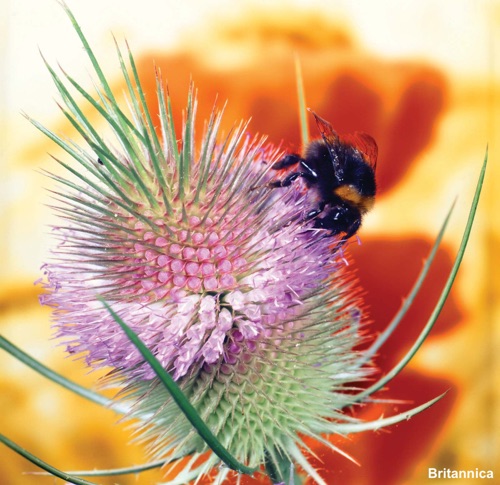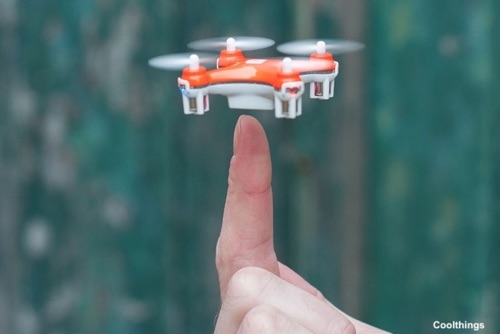News
15 December 2022
Pollinators are declining rapidly - Rather than protecting them, some are getting mobilized (and invest) for replacing them!
While in Montréal, Canada, COP15 on biodiversity is working on the development of a global action plan to prevent a sixth mass extinction, it seemed important to us to revisit a topic that we had already dealt with in the past [read here and here, p. 10], namely pollination by insects and particularly by the quite emblematic bees.
As will be seen, the way to address the issue of biodiversity is also emblematic of the behaviour of our societies. Rather than questioning a profit-guided global food system whose negative economic, social and environmental impacts undermine sustainability, they aggravate the situation by “solving” their problems with absurd “solutions” whose consequences and risks are easy to anticipate.
It is a bit as if humanity, instead of employing its resources to solve its problems on Earth, decided to use its intellectual, technological and financial capacity to engage in an extravagant project aiming at making a planet B liveable that is as inhospitable as Mars. (Does this remind you of something or someone?) It is as if one implemented the mad undertaking that Frank J. Tipler was proposing to humanity, in the mid 1990s, and that amounted to consuming the matter of which the Earth is made to draw from it the energy required to go and conquer the universe and immortality1 !
The importance of pollinating insects
Insect pollination involves 90% of plant species with flowers, in the world, and 84% of cultivated plants in Europe.

Among the thousands of pollinating insects, the best known are certainly bees. However, many other insects (ants, wasps, butterflies, beetles such as chafers, or flies, mosquitoes and midges) have an important function in pollination. Moreover, other animals like some birds and bats are also major pollinators. [read]
Pollinating insects have a key role in food production. In France, a study conducted by the ministry of the Environment, Energy and the Sea in the mid 2010s found that 72% of the species cultivated for food depended on the action of pollinating insects [read in French]. At world level, it is estimated that pollinators are responsible for around 35% of food production and contribute to the increase by 75% of the yield of the most important food crops [read]
Diminishing pollinating insects
The decline of pollinating insects is a global trend that results from an accelerated reduction of the number of insects as described by a series of studies that found, for example, that up to 75% of the insect biomass have disappeared in protected areas of Germany and in the forests of Puerto Rico, that there was a decrease by more than 50% of insects flights over the American Great Lakes, and a fall by up to 55% of pollinating insects in Great Britain.
Unfortunately, data on insect population are quite incomplete and are particularly missing for many parts of the world. Further estimates show that this trend is a complex phenomenon, that impacts differently on different species, some of them even increasing in numbers in some territories [read].
Generally speaking, the presence of pollinators depends on two main factors: the availability of areas that offer a suitable habitat and the availability of adequate feed. Both of these factors are strongly influenced by human activity that is one of the causes of the decreasing number of pollinators. Climate change is another cause as it modifies the plant life-cycle and the composition of flora, while invasive species also disrupt and impact on the volume and structure of insect populations.
The main human activities affecting the existence of pollinating insects are:
-
•Intensive agriculture, which leads to uniformity of landscapes, impoverishment of vegetation, disappearance of habitats (in particular through the removal of forests and hedges) and to the ever-increasing pollution by toxic pesticides spread by agricultural activities.
-
•Soil artificialization (through various constructions such as roads, car parks, buildings and concrete areas), which also has a responsibility in the destruction of habitats of pollinators (70% of wild bees nest in the soil) and the reduction of the number and diversity of wild flowers whose nectar is the main feed for pollinators [read in French].
Given the immense importance of pollinating insects in human food, their disappearance is an extremely serious threat to global food security.
Solutions used for address the decline of pollinators
In addition to attempts to protect pollinators that, for the time being, do not seem to be able to cope with their collapse, a certain number of initiatives exist to ensure crop pollination by various means.
-
•Moving pollinators
In the Central Valley of California, in the US, which is dedicated to the monoculture of nuts and where almond production covers nearly 650,000 hectares, pesticide use has such a dramatic effects on bees that it has become necessary to bring, every year, a million bee colonies from other parts of the country!
However, this solution, indispensable for preserving production, seems absurd and requires a lot of energy.
-
•Pollination by hand or drone
In China, an even more radical method is being used, as the disappearance of pollinating insects in some areas requires the pollination of trees by drone or by hand! [read]
In fact, to improve pollination by drones worldwide, there is a growing use of the so-called nano drones benefiting from a deep-learning capacity based on artificial intelligence [read] so as to sharpen their ability to recognize target flowers [read]. Sometimes, drones can be guided by satellites [read].

Some authors believe, however, that robot pollination is not currently viable from a technical and economic point of view and that it generates high environmental costs. Despite indisputable advances, current drones are still quite clumsy for simulating the complex relations existing between plants and their pollinators, and they only work properly for relatively “easy” crops like sunflower.
From an economic point of view, the cost incurred for mobilizing a swarm of nano-drones seems prohibitive. It was estimated that, even at a price of 10 dollars/machine, replacing natural pollination - if it were to disappear entirely - would cost several hundred billion dollars. Manufacturing and operating these nano-machines would require the extraction of an enormous amount of minerals and the consumption of large quantities of energy, as well as solving issues of range that are a major constraint. Moreover, using these machines would also generate a huge mass of waste as and when they reach their end-of-life stage.
In addition, the invasion of the environment by these swarms of nano robots would also have serious impacts on existing ecosystems, in particular on pollination of non-targeted plants [read].
Despite these dangers, there are many researchers working on the improvement of pollinating nano drones, with the hope to find more efficient and less costly solutions. This is illustrated by the number of scientific publications on this topic during 2022.
-
•Insecticide-resistant bees
In the field of pollination, two methods are currently envisaged to make pollinators resistant to the most frequently used insecticides. Ongoing research is especially important in the case of bees.
The first method consists in trying to improve the bacterial microbiome2 of bees to give them the capacity to better digest and detoxify their food. It is recalled here that, like for humans, the digestive tract of bees is populated by myriads of microorganisms that take part in the digestion of their food and provide many other services. Changing the microbiome can be achieved by feeding bees with a mix of probiotics3 that is supposed to increase their resistance to toxic elements, especially pesticides [read]. For now, this solution is, however, not very effective and requires the repeated provision of probiotics as they do not remain for long in the body of bees.
The second method consists, in theory, to make bees resistant by inducing a genetic mutation that would make them able to metabolize pesticides. This has, so far, been achieved “in vitro” on cells. Public sector and university researchers are working on this [read here and here]. The corporate sector too is conducting research in this field, in particular Monsanto that intends to become a model defender of bees despite being one of the main providers of toxic material responsible for their decline. For this, in 2015, the agrochemical multinational bought Beeologics, a start-up involved in the development of a solution based on the RNA interference technology on which hungerexplained.org had already drawn attention a few years ago in the context of the production of “new insecticides” [read]. Monsanto is also a member and sponsors the Honey bee health coalition [read in French], thus probably seeking to improve its image. Creating these resistant bees may appear as a great idea, but it could eventually carry serious risks if ever a malicious person applied it “accidentally” to make pests resistant… In addition, if such a super-bee existed, there are fears that it could eradicate all other bees [read].., and reduce biodiveristy!
Conclusion
Based on this brief situation review, one can only hope that, instead of being dazzled by technology, obsessed by the quest for financial profit and drawn towards non-sustainable or dangerous solutions seeking to replace pollinators by robots or make them resistant to pesticides, the world will make efforts needed to create the conditions required for protecting these key allies of humanity, especially by accelerating the transition towards more sustainable food systems that do not depend any more on the use of toxic products and that do not contribute to climate change.
This conclusion applies to pollinators, but also to the whole of biodiversity that provides humanity environmental services that are essential for survival, and particularly so for food. It should also be further extented to all types of life on Earch, rather than, reaching a point of total absurdity, spending colossal amounts of money to “re-create” extinct species4.
---------------------
Notes
-
1.Tipler, F. J. The physics of immortality, Anchor Books, 1995.
-
2.Microbiome: collection of genomes of all the microorganisms naturally living in an organism.
-
3.Probiotics: mixture of live microorganisms that, when consumed, is supposed to bring health benefits.
-
4.This what Colossal Biosciences is aiming to achieve, after having mobilized more than $220 millions, by recreating three extinct animals: the dodo, the tasmanian tiger and the woolly mammoth.
————————————-
To know more :
-
•Jactel, H., et al., Insect decline: immediate action is needed, Biologies, 2020.
-
•Rowe, M. From gene editing to robotic honey bees: the pollinator crisis and new technology, Geographical/Medium. 2019.
-
•IPBES, The global assessment report on biodiversity and ecosystems services - Summary for policymakers, 2019.
-
•Potts, S.G. et al., Robotic bees for crop pollination: Why drones cannot replace biodiversity, Science of the Total Environment, 2018.
-
•Warner, B., Invasion of the ‘frankenbees’: the danger of building a better bee, The Guardian, 2018.
-
•FAO, Sustainable agriculture for biodiversity - Biodiversity for sustainable agriculture, 2018.
-
•Ministère de l’Environnement, de l’Énergie et de la Mer, Évaluation française des écosystèmes et des services écosystémiques - Rapport intérimaire, 2016 (in French).
Selection of past articles on hungerexplained.org related to the topic:
Last update: February 2023
For your comments and reactions: hungerexpl@gmail.com


